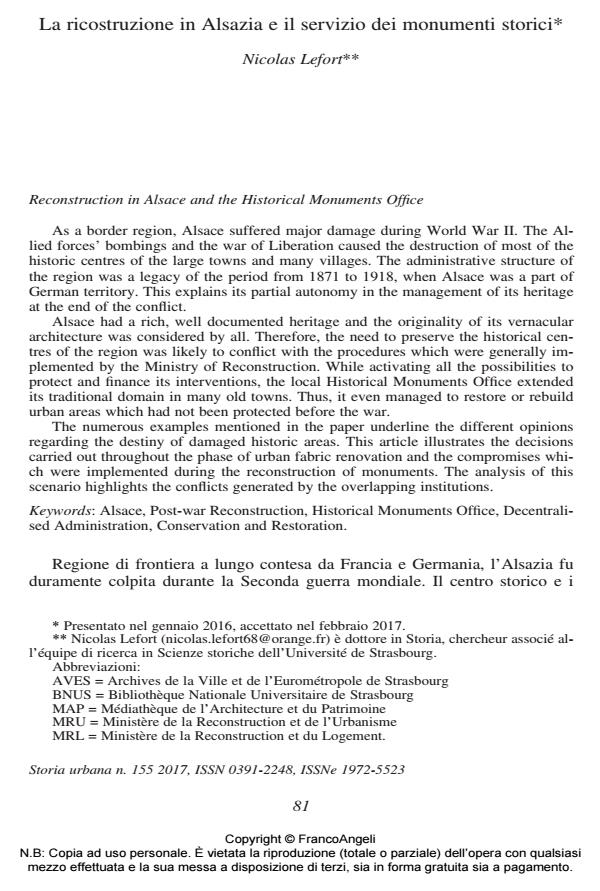La ricostruzione in Alsazia e il servizio dei monumenti storici
Titolo Rivista STORIA URBANA
Autori/Curatori Nicolas Lefort
Anno di pubblicazione 2017 Fascicolo 2017/155
Lingua Italiano Numero pagine 25 P. 81-105 Dimensione file 3266 KB
DOI 10.3280/SU2017-155005
Il DOI è il codice a barre della proprietà intellettuale: per saperne di più
clicca qui
Qui sotto puoi vedere in anteprima la prima pagina di questo articolo.
Se questo articolo ti interessa, lo puoi acquistare (e scaricare in formato pdf) seguendo le facili indicazioni per acquistare il download credit. Acquista Download Credits per scaricare questo Articolo in formato PDF

FrancoAngeli è membro della Publishers International Linking Association, Inc (PILA)associazione indipendente e non profit per facilitare (attraverso i servizi tecnologici implementati da CrossRef.org) l’accesso degli studiosi ai contenuti digitali nelle pubblicazioni professionali e scientifiche
As a border region, Alsace suffered major damage during World War II. The Allied forces’ bombings and the war of Liberation caused the destruction of most of the historic centres of the large towns and many villages. The administrative structure of the region was a legacy of the period from 1871 to 1918, when Alsace was a part of German territory. This explains its partial autonomy in the management of its heritage at the end of the conflict. Alsace had a rich, well documented heritage and the originality of its vernacular architecture was considered by all. Therefore, the need to preserve the historical centres of the region was likely to conflict with the procedures which were generally implemented by the Ministry of Reconstruction. While activating all the possibilities to protect and finance its interventions, the local Historical Monuments Office extended its traditional domain in many old towns. Thus, it even managed to restore or rebuild urban areas which had not been protected before the war. The numerous examples mentioned in the paper underline the different opinions regarding the destiny of damaged historic areas. This article illustrates the decisions carried out throughout the phase of urban fabric renovation and the compromises which were implemented during the reconstruction of monuments. The analysis of this scenario highlights the conflicts generated by the overlapping institutions.
Parole chiave:Alsace, Post-war Reconstruction, Historical Monuments Office, Decentralised Administration, Conservation and Restoration.
- Recent Articles on French History Jean-Pierre Hérubel, in French Historical Studies /2019 pp.154
DOI: 10.1215/00161071-7205281
Nicolas Lefort, La ricostruzione in Alsazia e il servizio dei monumenti storici in "STORIA URBANA " 155/2017, pp 81-105, DOI: 10.3280/SU2017-155005